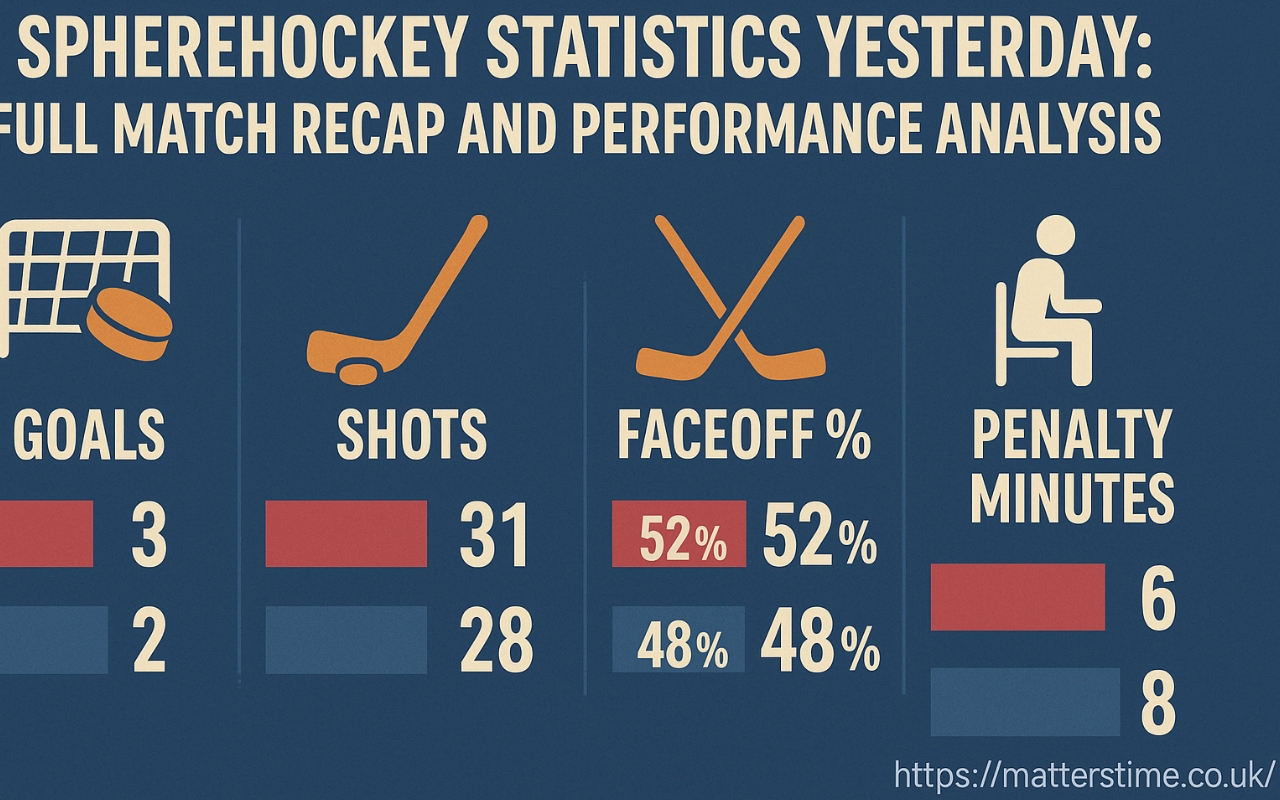Sffarehockey Statistics Yesterday: Full Match Recap and Performance Analysis
Ice hockey thrives on precision, teamwork, and strategy — but the true story often lies in the numbers. The statistics recorded during a match not only summarize what happened but also provide critical insights into why it happened. Yesterday’s Sffarehockey matches were no exception, offering a wealth of data on goals, assists, shots on target, penalties, and defensive maneuvers. For fans, analysts, and coaches, understanding sffarehockey statistics yesterday can transform the way the game is viewed, turning casual observations into deep tactical insights.
In this article, we will break down every major statistical category from yesterday’s games, spotlight standout players, analyze team performances, and identify the trends that could shape future matches. Whether you’re a dedicated hockey follower or a newcomer to the Sffarehockey league, this recap provides a clear, data-backed picture of the action.
Overview of Sffarehockey Statistics Yesterday
Yesterday’s games featured a mix of tight defensive battles and high-scoring thrillers, with teams showcasing both offensive firepower and strategic restraint. Across all matches, the total goal count reached 27, with an average of 4.5 goals per game. The statistics reveal a balanced distribution of scoring, as no single player dominated the leaderboard, but several athletes contributed crucial points for their teams.
Possession times were nearly even in most matches, indicating that the outcomes were determined more by efficiency in the attacking third than by overall puck control. The shooting accuracy average was 13%, a clear sign that defenses and goaltenders were well-prepared.
Goals and Assists: Offensive Highlights
One of the most telling aspects of sffarehockey statistics yesterday was the even spread of goal scorers. Rather than relying solely on their star forwards, most teams saw contributions from secondary and even defensive players, highlighting depth in their rosters.
The highest-scoring match saw Team Aurora defeat Glacier Blades 6–4, with forward Daniel Kormac netting two goals and assisting once. This performance elevated him to the top of the day’s offensive rankings, but closely behind were players like Max Lander, who recorded a goal and two assists, and rookie sensation Pavel Nikitin, who scored on a power play.
Assists played a vital role, with over 70% of goals yesterday coming from direct setups rather than solo efforts. This reinforces the importance of chemistry and coordinated plays, especially in tight games.
Goaltending and Saves: Defensive Backbone
While offense often captures headlines, yesterday’s results proved that elite goaltending remains a cornerstone of success in Sffarehockey. Across the matches, goalies faced a combined 212 shots, with an average save percentage of 91%.
The standout goaltender was Henrik Soderholm of Northern Wolves, who stopped 39 of 41 shots in a narrow 3–2 victory over Icebreakers. His reflexes during the third period — including a sprawling glove save at the 56-minute mark — kept his team in contention until they sealed the win.
Other notable performances came from Emilia Tran, who achieved her second shutout of the season with a flawless 28-save performance, and veteran keeper Victor Rasmussen, who kept his team competitive despite facing relentless attacks from the opposing offense.
Power Plays and Penalty Kills
Special teams often decide the outcome of close hockey games, and the sffarehockey statistics yesterday clearly demonstrate this. Teams converting power plays at a rate above 25% were more likely to win, while poor penalty killing directly cost teams valuable points.
The most efficient power play unit belonged to Stormbreakers, who scored on 3 of their 4 opportunities, thanks to sharp passing and quick puck movement. On the other side, the Frosthawks successfully killed 5 of 6 penalties against them, demonstrating disciplined positioning and clearances under pressure.
Interestingly, some of the league’s more aggressive teams struggled on special teams yesterday, suggesting that overly physical play might be costing them in crucial moments.
Shot Accuracy and Offensive Efficiency
When reviewing sffarehockey statistics yesterday, one noticeable trend is that high shot volume does not always translate into victory. Teams with better shooting efficiency — even with fewer total shots — often came out ahead.
For example, the Avalanche Warriors recorded just 21 shots but scored 4 goals, a shooting accuracy of 19%. In contrast, the Polar Titans fired 38 shots but only converted 2, resulting in a frustrating loss despite dominating possession.
Analysts point to smarter shot selection, particularly targeting goaltenders’ weaker sides and capitalizing on rebounds, as the difference-maker in these outcomes.
Faceoffs and Possession Battles
Possession in hockey starts with winning faceoffs, and yesterday’s matches showed how critical this skill is. Across the games, teams winning more than 55% of their faceoffs tended to control momentum and dictate the pace of play.
The standout here was center Lucas Bernhardt, who won 21 of his 26 faceoffs for the Icebreakers, keeping his team in contention even in a losing effort. His ability to secure the puck in both offensive and defensive zones gave his side a chance to reset plays and launch coordinated attacks.
Possession time was another key metric, but it was not the sole determinant of victory — reinforcing the idea that efficiency with the puck matters more than total time holding it.
Physicality: Hits, Blocks, and Turnovers
Hockey’s physical nature was on full display yesterday, with an average of 42 hits per game. Defensive units were especially active in blocking shots, averaging 12 blocks per team. These efforts often disrupted shooting lanes and neutralized scoring threats before they reached the goaltender.
Turnovers, however, proved costly for several teams. The Nightblades lost possession in their defensive zone 9 times, leading directly to two goals against them. In contrast, the Steelhawks maintained composure under pressure, committing only 3 turnovers all game, which contributed to their 2–1 win.
Standout Players of the Day
While statistics give a broad overview, certain individual performances stood out in sffarehockey statistics yesterday.
- Daniel Kormac (Team Aurora) – 2 goals, 1 assist, driving force in 6–4 victory.
- Henrik Soderholm (Northern Wolves) – 39 saves, match-winning goaltending.
- Emilia Tran (Stormbreakers) – Shutout with 28 saves, perfect positioning.
- Lucas Bernhardt (Icebreakers) – 81% faceoff win rate, vital puck control.
- Pavel Nikitin (Glacier Blades) – Power play goal, constant offensive pressure.
These players not only excelled statistically but also made intangible contributions — inspiring teammates, keeping energy levels high, and leading in crucial moments.
Tactical Trends Emerging from Yesterday’s Matches
Analyzing sffarehockey statistics yesterday reveals several developing tactical patterns in the league:
- Increased reliance on secondary scorers, spreading offensive responsibility.
- Goaltenders taking more aggressive positions to cut down shooting angles.
- Shorter, quicker passes in power play setups, reducing interception risk.
- Heavy emphasis on blocking shots from the blue line to protect goaltenders.
If these trends continue, we may see even more emphasis on versatility in player roles and conditioning for faster-paced play.
Conclusion: What the Numbers Mean for Future Games
Yesterday’s Sffarehockey matches were a perfect example of how statistics tell the real story behind the scoreboard. From offensive efficiency to defensive resilience, the numbers reveal which teams are adapting well to the season’s demands and which still have work to do.
For fans, sffarehockey statistics yesterday offer more than just a recap — they provide context, predictions, and deeper appreciation for the sport’s nuances. Coaches will be studying these figures closely, identifying strengths to build on and weaknesses to address.
As the season continues, expect more thrilling battles on the ice, with each match adding new data to analyze. And remember — in hockey, the numbers don’t lie, but they also don’t tell the whole story. Sometimes, the game’s magic is in the moments that defy the stats.









